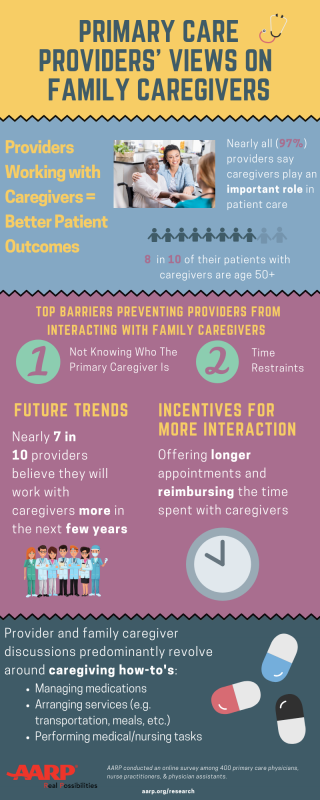Majority of Primary Care Providers Recognize Importance of Family Caregivers in Patient Outcomes
En español | WASHINGTON—Primary care providers agree, almost unanimously, that family caregivers play a vital role in patient care and in better patient outcomes, according to a new survey by AARP Research. However, providers say that time constraints and not knowing who or if there is a family caregiver prevent them from working with family caregivers for more of their patients.
“Today, forty million Americans are caring for aging parents, spouses and other loved ones, and close to half of them are responsible for medical tasks like injections and wound care,” said AARP Executive Vice President and Chief Advocacy & Engagement Officer Nancy LeaMond. “Delivering more treatment on an outpatient basis means that family caregivers are critical members of patient care teams. The entire health care system – from providers to hospitals to insurers – must recognize family caregivers’ critical role and understand that teaming up with them can improve health outcomes and quality of life for both patients and family caregivers.”
AARP Research conducted a survey of 400 primary care physicians, nurse practitioners and physician assistants to understand their perceptions and interactions with family caregivers, their knowledge of available caregiver resources and potential barriers to working with them.
Key Findings
Nearly all primary care providers (97 percent) said that family caregivers play an important part in patient care. They reported that sharing patient information with caregivers leads to better patient outcomes, higher patient and caregiver satisfaction and lower hospital readmission rates. The survey found that most provider-family caregiver discussions involve instructions on managing medications, performing medical and nursing tasks, and arranging transportation, meals and other services.
Barriers to Family Caregiver Interaction
Health care providers gave the following top reasons for not interacting with more family caregivers:
- Patients had multiple caregivers
- Not aware of caregiver identity
- Fluctuations in caregiver involvement
- Too time consuming
Providers said that lack of time is also a key barrier for nurses and receptionists in working with family caregivers.
“Primary Care Providers Experiences with Family Caregivers Survey” is available at www.aarp.org/caregivinghealthprovidersurvey.
Additional Resources:
# # #
About AARP
AARP is the nation’s largest nonprofit, nonpartisan organization dedicated to empowering people 50 and older to choose how they live as they age. With a nationwide presence and nearly 38 million members, AARP strengthens communities and advocates for what matters most to families: health security, financial stability and personal fulfillment. AARP also produces the nation's largest circulation publications: AARP The Magazine and AARP Bulletin. To learn more, visit www.aarp.org or follow @AARP and @AARPadvocates on social media.
MEDIA CONTACT: Greg Phillips, 202-434-2560, gphillips@aarp.org, @AARPMedia
































































